Elvis Presley–Signed Copy of the Book of Mormon a Forgery, Historian Says
Contributed By Keith A. Erekson, Church History Library Director
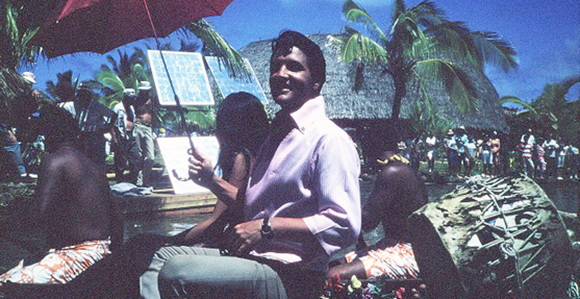
In the film Paradise, Hawaiian Style, Elvis rides a canoe past the island villages of the Polynesian Cultural Center while singing “Drums of the Islands,” a song originally written by Fijian musician Ratu Isireli Racule, who later joined the Church.
Article Highlights
- A copy of the Book of Mormon thought to have been signed by Elvis Presley has been confirmed to be a forgery.
Related Links
For almost 30 years, a copy of the Book of Mormon has been preserved in the historical collections of The Church of Jesus Christ of Latter-day Saints. The book was published in 1976 with a soft, light blue cover featuring a golden angel Moroni. Within the book there are handwritten markings on nearly one of every six pages—the majority are underlining or curved brackets, but three dozen of the pages contain handwritten words. The first page contains the signature “E. A. Presley” and on the last page (in the index) was written, “Father, I want more! I need more now. Help me!” The content and placement of the annotations suggest that Elvis Presley read this copy of the Book of Mormon from cover to cover.
The idea of Elvis Presley cherishing the Book of Mormon has captured the popular imagination of Latter-day Saints. The story of this book has been told by fireside speakers, classroom teachers, newspaper columnists, and an independent filmmaker. And the story continues to circulate throughout the market for “uplifting” books and social media.
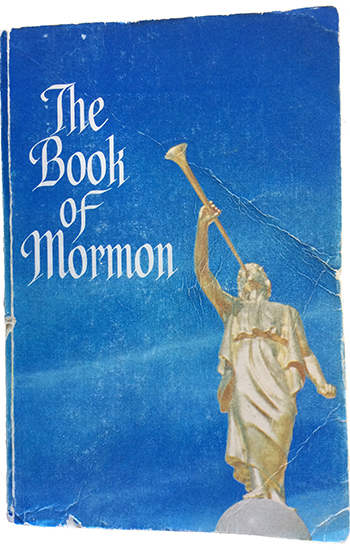
This copy of the Book of Mormon was donated to the Church in 1989 with forged annotations purportedly made by Elvis Presley. Photo by Keith A. Erekson.
However, after carefully analyzing the historical opportunities for Presley to have read this volume and the handwriting throughout its pages, I affirm that Elvis Presley did not write in this Book of Mormon. A detailed presentation of the analysis with photographic evidence will be published in a forthcoming issue of BYU Studies, but my findings about the book’s history, its forged signature, and its forged annotations are summarized here.
The book’s donor claimed to have given the book to Elvis Presley on August 2, 1977. Elvis died 14 days later, and the book was allegedly returned to the donor who shared it with a few people before it was transferred to the Church in 1989. The last two weeks of Elvis’s life were very busy. His nine-year-old daughter, Lisa Marie, had arrived on July 31 and he entertained her by renting out a local amusement park, screening several films, and spending an evening visiting the family of his then-current girlfriend. The day of his death was supposed to be the day he departed on tour, so much of those two weeks were spent reviewing plans and details, avoiding and reluctantly starting a liquid diet, and playing racquetball once. And Elvis also reeled from the August 6 publication of a devastating exposé of his prescription drug abuse and violent behavior. It is very unlikely that Elvis read and pondered nearly 600 pages of scripture during these 14 event-filled days.
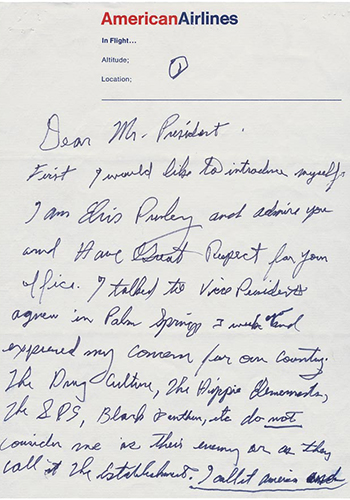
Elvis Presley’s jerky handwriting and authentic signature can be seen in this letter to President Richard Nixon dated December 21, 1970. Photo courtesy of the National Archives and Records Administration.
The signature on the first page of the book is a clear forgery. Elvis signed his full name for autographs, but he did sign with just his initials on formal documents. Despite a general resemblance to his signature, significant differences appear in nearly every letter, the most dramatic being that the “P” is connected to “resley,” a closed-bottomed “s,” and the omission or serious misformation of the second “e” in Presley.
Whatever effort the forger put into making the signature look authentic was not spent on the rest of the annotations. Elvis’s authentic handwriting was erratic, jerky, and childish-looking—and grew worse over time due to stress and drug abuse. He was, in fact, a reader and an annotator of books, underlining text and writing in the margins in printed block letters. In contrast, the handwriting in this volume is cursive script and so smooth and mature that it is clearly forged.
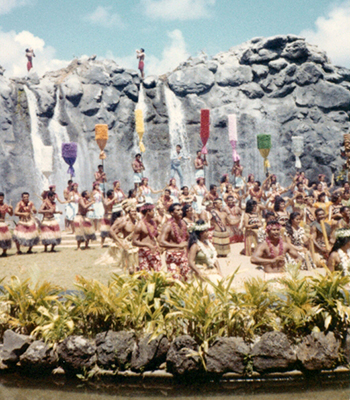
Elvis performed with PCC cast members from all of the island villages in the finale of the film Paradise, Hawaiian Style. Photo courtesy of BYU–Hawaii Archives.
Experts in authenticating Elvis Presley’s handwriting corroborate these findings. Music industry autograph authenticator Roger Epperson wrote: “In my opinion this is not written or signed by Elvis. The signature has some similarities to an authentic signature, but the writing is not really even close.” Rich Consola, owner of Elvis Presley Authentication, concluded: “After reviewing the signature of Elvis Presley and all the writing in this book, it is my opinion that NONE of the writing and the signature are that of Elvis Presley. To this end I am very certain.”
Elvis Presley did not write in the Book of Mormon now held by the Church History Library. Annotations suggesting that Elvis wanted to be baptized, that he believed his daughter needed the Church, and that he suspected his death was imminent are fabrications manufactured to deceive. Forgeries are often accepted because they provide something that people already want—in this case, a story of the conversion of a celebrity.
Did Elvis have any verifiable connections to the Church? Yes. He spent a week at the Polynesian Cultural Center filming the movie Paradise, Hawaiian Style. He was also acquainted with the Osmond family, exchanging gifts and sharing the same drummer and jumpsuit designer in Las Vegas. Elvis’s best-documented Latter-day Saint friend was his karate instructor and later bodyguard, Ed Parker.
What about those who felt inspired by a story that now turns out to be false? One lesson to learn is to seek corroboration before retelling a story. Errors arose in the repeated tellings of this story—that Elvis underlined “king” throughout, that he wished “Priscilla” would read it, or that he wrote “There is only one King.”
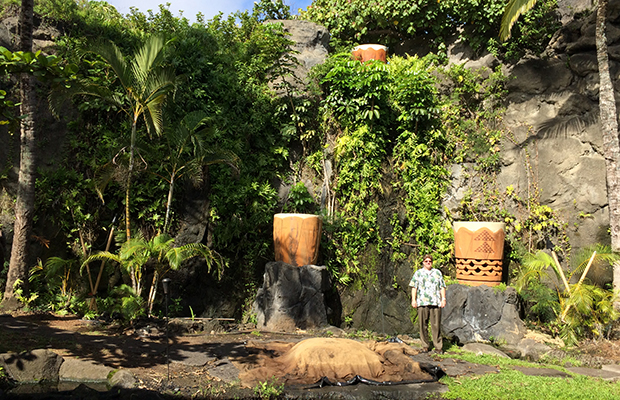
The place where Elvis performed the finale for Paradise, Hawaiian Style forms the lushly foliaged stage of the Hale Aloha Theater, site of evening luaus at the Polynesian Cultural Center. Photo courtesy of Keith A. Erekson.
